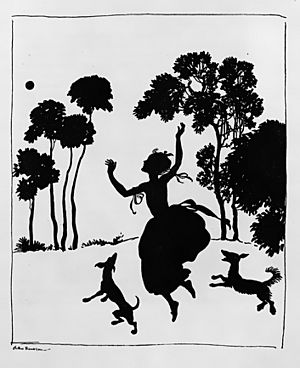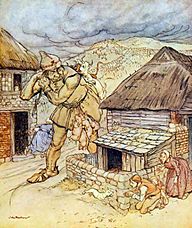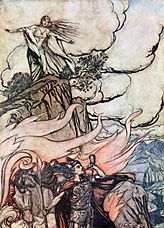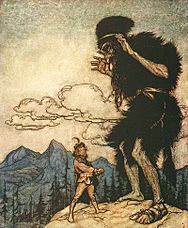Arthur Rackham facts for kids
Quick facts for kids
Arthur Rackham
|
|
|---|---|

Self-portrait, 1934
|
|
| Born | 19 September 1867 London, England
|
| Died | 6 September 1939 (aged 71) Limpsfield, Surrey, England
|
| Known for | Children's literature, Illustration |
Arthur Rackham (born September 19, 1867 – died September 6, 1939) was a famous English artist who illustrated books. He is known as one of the most important artists during the "Golden Age" of British book illustration. His art is special because of his strong pen and ink drawings, which he often combined with watercolours. He learned this technique from his early job as a newspaper illustrator.
One of his most important works was the 51 colour pictures he made for the American story Rip Van Winkle. These illustrations helped change how books were made because they showed how to print colour artwork very accurately. Some of his other well-known works include illustrations for Peter Pan in Kensington Gardens and Fairy Tales of the Brothers Grimm.
Contents
Arthur Rackham's Life Story
Rackham was born in London, England, and was one of 12 children. When he was 17, he traveled by ship to Australia to help his health. At 18, he worked as an insurance clerk and also studied art part-time at the Lambeth School of Art.
In 1892, he left his office job and started working for a newspaper called Westminster Budget as a reporter and artist. His first book illustrations were published in 1893. However, his first big art job was in 1894 for a book called The Dolly Dialogues. After that, illustrating books became his full-time career for the rest of his life.
Around 1900, Rackham became well-known for his fantasy drawings made with pen and ink. He illustrated popular gift books like The Ingoldsby Legends (1898), Gulliver's Travels, and Fairy Tales of the Brothers Grimm (both 1900). He also drew for children's magazines such as Little Folks. In 1903, he married his neighbor, Edyth Starkie. They had one daughter, Barbara, in 1908.
Rackham became very famous when his full-colour pictures for Washington Irving's Rip Van Winkle were published in 1905. His fame grew even more the next year with his illustrations for J.M. Barrie's Peter Pan in Kensington Gardens. He often showed his original artwork in exhibitions, which helped him earn more money. He won gold medals at international exhibitions in Milan (1906) and Barcelona (1912). His art was even shown at the Louvre museum in Paris in 1914. Rackham was a member of the Art Workers' Guild and became its leader in 1919.
The family lived in London until 1920, when they moved to Houghton, West Sussex. In 1929, they settled in a new home in Limpsfield, Surrey. Ten years later, Arthur Rackham passed away at home from cancer.
Why Arthur Rackham Was Important
Arthur Rackham is seen as one of the most important illustrators from the "Golden Age" of British book illustration. This period lasted from about 1890 until the end of World War I. During this time, there was a big demand for high-quality illustrated books, which were often given as Christmas presents. Many of Rackham's books were made in special, limited editions, often signed by him.
Experts agree that Rackham was one of the best illustrators of his time. One writer, Salaman, said that Rackham was unique because his "genius is so thoroughly original." He added that Rackham's elves were "elfish" and his witches and gnomes were "convincingly of their kind."
Another expert, Hamilton, wrote that Rackham brought new excitement to book illustration. His art, with its soft colours and detailed lines, used new printing methods to create amazing pictures and characters. These pictures made children's books more exciting and had a big impact on book illustration at the start of the 20th century.
Since his death, Arthur Rackham's works have become very popular in both North America and Britain. His images are often used on greeting cards, and many of his books are still available today. His original drawings and paintings are highly valued and sought after by art collectors.
Arthur Rackham's Art Style
Rackham's illustrations were mostly based on strong drawings made with pen and India ink. He developed his unique style from his early work as a newspaper illustrator. He combined these detailed line drawings with soft watercolour washes. This technique became possible because of new ways to reproduce art using photography. This meant that his drawings could be photographed and printed directly, without needing someone else to carve them onto wood or metal plates.
Rackham would first lightly sketch his ideas with a soft pencil. Then, he would carefully draw over them with pen and India ink. After the drawing was taking shape, he would erase the pencil lines. For his colour pictures, Rackham liked to use a printing method that used three colours to create delicate shades. Sometimes, to make sure the details were clear in the final print, he would go over his drawings with ink again after painting them. He also became known for using silhouette (dark shape) pictures, especially after World War I, as seen in his books Sleeping Beauty and Cinderella.
Rackham usually included both colour and black-and-white illustrations in his books. His art is often described as a mix of a northern European "Nordic" style and the Japanese woodblock art from the early 1800s.
Famous Books Illustrated by Arthur Rackham
- Sunrise-Land by Berlyn Annie (1894)
- The Sketch Book by Washington Irving (1895)
- The Zankiwank and the Bletherwitch by Shafto Justin Adair Fitzgerald (1896)
- Two Old Ladies, Two Foolish Fairies, and a Tom Cat by Maggie Browne (1897)
- Evelina by Fanny Burney (1898)
- Feats on the Fjord by Harriet Martineau (1899)
- The Greek Heroes by Barthold Georg Niebuhr (1903)
- Rip Van Winkle by Washington Irving (1905)
- Puck of Pook's Hill by Rudyard Kipling (1906)
- Peter Pan in Kensington Gardens by J.M. Barrie (1906)
- Alice's Adventures in Wonderland by Lewis Carroll (1907)
- The Ingoldsby Legends by Thomas Ingoldsby (reworked edition 1907)
- A Midsummer Night's Dream by William Shakespeare (1908)
- Tales from Shakespeare by Charles and Mary Lamb (reworked edition 1909)
- Fairy Tales of the Brothers Grimm by the Brothers Grimm (reworked edition 1909)
- Gulliver's Travels by Jonathan Swift (reworked edition 1909)
- Undine by Friedrich de la Motte Fouqué (1909)
- The Rhinegold and The Valkyrie by Richard Wagner (1910)
- Siegfried and Twilight of the Gods by Richard Wagner (1911)
- Aesop's Fables by Aesop (1912)
- Arthur Rackham's Book of Pictures (1913)
- Mother Goose: The Old Nursery Rhymes by Charles Perrault (1913)
- A Christmas Carol by Charles Dickens (1915)
- The Allies' Fairy Book with an introduction by Edmund Gosse (1916)
- Little Brother and Little Sister and Other Tales by the Brothers Grimm (1917)
- The Romance of King Arthur and His Knights of the Round Table by Alfred W. Pollard (1917)
- English Fairy Tales by Flora Annie Steel (1918)
- The Springtide of Life: Poems of Childhood by Algernon Charles Swinburne (1918)
- Some British Ballads (1918)
- Cinderella by Charles Perrault, ed. Charles S. Evans (1919)
- The Sleeping Beauty by Charles Perrault and the Brothers Grimm, ed. Charles S. Evans (1920)
- Irish Fairy Tales by James Stephens (1920)
- Snowdrop and Other Tales by the Brothers Grimm (1920)
- Comus by John Milton (1921)
- A Wonder-Book for Girls and Boys by Nathaniel Hawthorne (1922)
- Poor Cecco by Margery Williams (1925)
- The Tempest by William Shakespeare (1926)
- The Legend of Sleepy Hollow by Washington Irving (1928)
- The Vicar of Wakefield by Oliver Goldsmith (1929)
- The Compleat Angler by Izaak Walton (1931)
- The King of the Golden River by John Ruskin (1932)
- Fairy Tales by Hans Christian Andersen (1932)
- Goblin Market by Christina Rossetti (1933)
- The Pied Piper of Hamelin by Robert Browning (1934)
- Tales of Mystery & Imagination by Edgar Allan Poe (1935)
- Peer Gynt by Henrik Ibsen (1936)
- The Wind in the Willows by Kenneth Grahame (posthumous, 1940 US, 1950 UK)
Images for kids
-
"How at the Castle of Corbin a Maiden Bare in the Sangreal and Foretold the Achievements of Galahad", from The Romance of King Arthur and His Knights of the Round Table, by Alfred W. Pollard, 1917
-
"The giant Galligantua and the wicked old magician transform the duke's daughter into a white hind", illustration to English Fairy Tales, by Flora Annie Steel
-
"The giant Cormoran was the terror of all the country-side", illustration to English Fairy Tales, by Flora Annie Steel
-
"The Three Bears", illustration to English Fairy Tales, by Flora Annie Steel
-
"Siegfried leaving Brünnhilde", illustration to Richard Wagner's The Ring
-
"One day they were overheard by a fairy", illustration of Maimie and Tony in Peter Pan in Kensington Gardens
How Arthur Rackham Influenced Others
Rackham's unique art style inspired many other artists. These include Gustaf Tenggren, Brian Froud, William Stout, Tony DiTerlizzi, and Abigail Larson. Brian Froud has said that Rackham's early drawings, especially his "trees that had faces," made him interested in illustrating fairy tales.
The look of the 1977 animated film The Hobbit was based on Rackham's early illustrations.
Director Guillermo del Toro has also mentioned Rackham as an influence. He said that Rackham's dark and realistic drawings inspired the design of "The Faun" creature in his movie Pan's Labyrinth. In another one of his films, Hellboy, a tree growing out of an altar is even called a "Rackham tree" by the director because of its similar style.
See also
 In Spanish: Arthur Rackham para niños
In Spanish: Arthur Rackham para niños


















